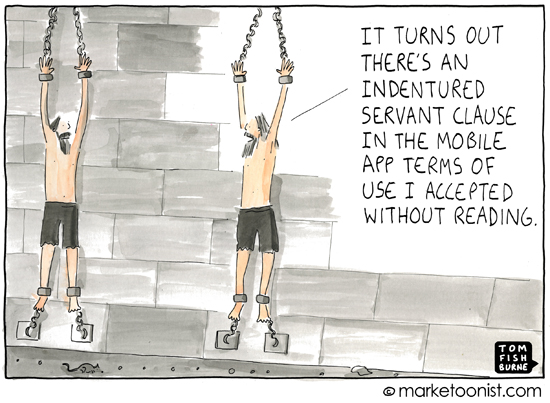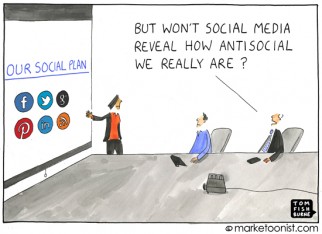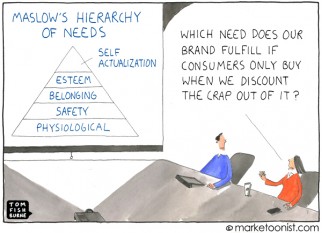The large print giveth and the small print taketh away. Consumers rarely read the small print. That’s partly because so much of it is written in legalese that is not easily understood. Who honestly reads the lengthy “terms of use” disclaimers we have to accept before using a mobile app or the iTunes clickthrough agreement?
Yet even legal disclaimers are part of the brand experience. Instagram learned this the hard way recently when they became front page news for updating their terms of use to have more control over the pictures of their community. The convoluted legalese only made the situation worse.
Tech companies are some of the biggest offenders of confusing legal disclaimers, with constant policy changes that their audiences can’t easily understand. I stumbled across a funny post that tries to decode Facebook’s legalese by translating “The Entire Facebook Terms Of Service in Bro Speak“.
Techcrunch posted an interesting article on this phenomenon, “Tech Companies, You’re Killing Yourself With Scary Legalese“.
“You always fear what you don’t understand. Tech companies need to wise up and end the cycle of pushing policy updates in confusing legal terms, watching press and users alike panic and threaten to jump ship, and then issuing an apology and clarification. The fact is that the outcry is always louder than the apology. People don’t get the memo, and you lose users or at least trust.”
In a funny story around the same time as Instagram, even Randi Zuckerberg (Mark’s sister) was confused by Facebook’s convoluted privacy policy and accidentally shared a private picture that went viral.
The lessons are relevant to any marketers, tech or not. Lawyers are not always considered part of the marketing team. But the brand voice extends to the small print as well as the large print. Brands today are judged by both.
(Marketoonist Monday: I’m giving away one signed print of this week’s cartoon. Just share an insightful comment to this week’s post by 5:00 PST on Monday. I’ll pick one comment. Thanks!)



Tessa Stuart says
I recently went to get a new phone. I had phoned up to check when the contract ended, and when I could get a new phone, and it all seemed to be fine that I could upgrade and start a new contract without any financial penalty. But when I walked into the store, they said the terms of the contract agreement with me had changed. Had they notified me of this? No. How did I feel? Annoyed and cross. So we then went through the charade we do every single time of me threatening to leave the network, in order to force a better price out of my supplier, because they give new customers better deals than they do to existing clients. Which seems to me all wrong, considering the amount I pay them, and the fact that in all other ways I am happy with them. Financial services companies also play the same tricks.
Charity says
This is fantastic! I wonder what it will take for companies to realize that they are only hurting their own brand by requiring such complicated terms? If Zuck’s own sister can’t figure it out with her vast tech experience, how can my children or my grandparents?
I also wonder how long it will take our government to rule the agreements we’ve made void/invalid. I’ve occasionally pondered if we are actually in legal agreements with these companies, based on the fact that the companies make their terms too complicated for the average person to understand and because you don’t actually have to read the terms before clicking the “agree” button. A 2-year old can click a brightly colored button without understanding the meaning. Eventually all of this will come to a head in the supreme court – when users get the clarification they need and deserve.
The Internet is a complicated thing, truly a web with strings attached to everything growing thicker and more scary by the moment. And at the same time, it is also a beautiful creation – when you can see it! That said, have you ever walked into a spider web? Were you able to “calmly” peel away the silken strings? If you’re like me, you run, flail, wildly swipe at the invisible web until you’re free. Sometimes it’s like that online! Just watch and see what happens when someone accidentally posts a photo and they can’t figure out how to delete it! In my case, a couple of years ago someone posted a terrible comment on a picture I’d shared with numerous tags. I panicked! While driving down the road, I longed for a Facebook app that would allow me to remove the offensive comment from my profile. I furiously downloaded and installed Opera onto my phone, logged to Facebook, found the comment, and deleted it. It took too long. How many others that were tagged saw the comment? I’ll never know but I’ll remember the panicked feeling for the rest of my life.
I’d like to see something done in upcoming years regarding privacy policies, copyright (which is an outdated set of laws), and terms of service text. But, I won’t hold my breath. Meanwhile, I’ll continue to watch out for spider webs in the dark and be careful who I friend on Facebook.
Rich Binell says
Why companies use disclaimers, and the fatal flaw behind them.
The reason there are “legal disclaimers” is because companies rely on lawyers to reduce their risks.
Because.
Reducing risks is part of their responsibility to shareholders.
So.
Companies get in the habit of sending everything they publish to their corporate lawyers.
Including Marketing materials.
Except.
Marketing success is measured on impact.
And.
Impact requires big promises.
And.
Big promises are risky, because when you make a marketing promise, you incur the risk that you must deliver, or you suffer the consequences to your company or your brand if you don’t.
So.
Companies send their marketing materials to lawyers first.
And.
Lawyers are not in the business of increasing impact.
Plus.
They never ask, “How will my decisions decrease impact and sales?”
Instead.
They do ask, “How can I mitigate risk and avoid costly lawsuits?”
So.
They either remove risky promises and statements from the marketing materials.
Or.
They write lengthy legal disclaimers.
Which means.
Marketing materials and promises are watered down, softened, ironed-out, unwrinkled, and made unobjectionable and unenfordeable by people who have no stake in making the marketing materials successful.
Or.
They are handed the small print to print somewhere by the lawyers.
Now.
If you were a Marketing person whose bonus depends on your ability to impact the target audience and deliver qualified leads, which option would you choose:
Door 1—Less impact, or
Door 2—A legal disclaimer nobody can read because it’s printed in 6 point type on the inner flap of the mailing envelope?
A few choose both.
But the majority opt for Door 2.
I would.
You would, too.
The real issue, the one that no one considers, is that the lawyers might be wrong.
Big promises might bring no lawsuits.
Or.
They might bring so many sales that they dwarf the lawsuits.
And.
The background noise of nuisance lawsuits might happen no matter what you do or don’t do, say or don’t say.
That is my point.
That is the consideration worth considering.
The lawyers might be completely, mistakenly, sales-impactingly, unquestionably—wrong.
Rich Binell says
PS-A friend bought a t-shirt silkscreening machine and asked what I’d put on a t-shirt.
Being a writer, a lot of things came to mind.
I was frozen by indecision.
So he asked me a different way.
He said “You never wear t-shirts.
What would I have to put on a t-shirt to get you to wear it?”
I said “Easy. A Tom Waits quote from Small Change. A song called Step Right Up.”
He asked what the quote was.
“The large print giveth, and the small print taketh away.”
He loved it.
I still have the shirt.
And sometimes, I wear it.
Karl Sakas says
It can go both ways! A client (the communications team at a state government agency) couldn’t use Google Analytics on their new website, because their legal team didn’t like the Terms & Conditions.
Specifically, the client’s legal team wouldn’t sign a contract where the legal venue was in another state, and Google wouldn’t change the terms from California to North Carolina.
I’d never seen that before — every other web development client I’ve ever worked with has never had a problem about using Google Analytics as-is. For a free product, I can see why Google didn’t want to budge.
Safi Ghauri says
Personally I hate legalese and don’t read all the terms of use. What would be good is if the terms of use came in a carton format to make them easier to read and understand – You should have a go one day Tom! In fact I’m sure marketers and consumers would love this, although the legal guys would probably hate it.
tomfishburne says
Hi all,
Great commentary this week, thanks! Really great stories on cellphones and Facebook from Tessa and Charity. This week’s print goes to Rich for hitting the nail on the head with the motivations that lead to such complicated TOCs.
Thanks!
-Tom